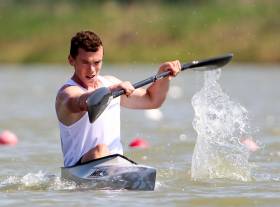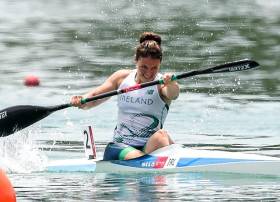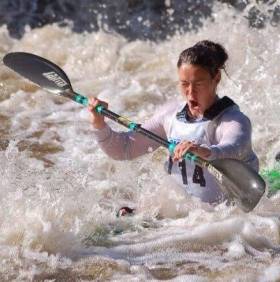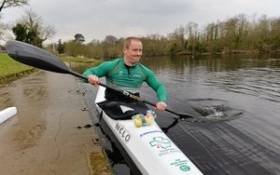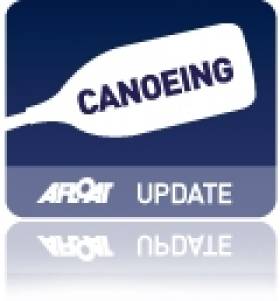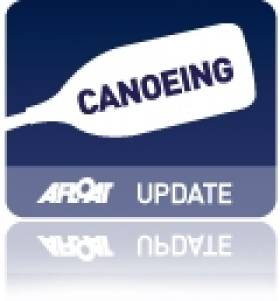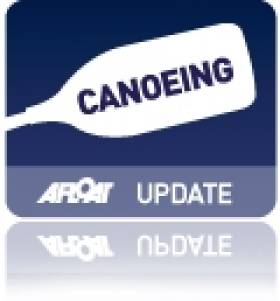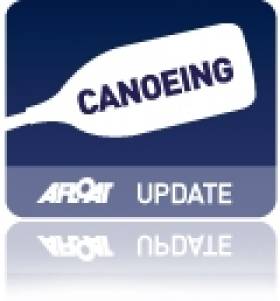Displaying items by tag: Duisburg
Egan Seventh in Second Olympic Qualifier Final
#Canoeing: Jenny Egan finished seventh in her K1 200m final at the canoe sprint European Olympic Qualifier in Duisburg in Germany today. Germany and Sweden secured the top two spots, and with them places at the Olympic Games in Rio de Janeiro. Egan was in the middle of the group from third to ninth who were covered by less than a second. The Irishwoman was competing in her second final of the day.
Tom Brennan finished ninth in his final of the K1 200, with the top two of Spain and Hungary qualifying for Rio de Janeiro.
Canoe Sprint European Olympic Qualifier, Duisburg, Germany (Selected Results, Irish interest)
Men
K1 1,000 – Final: 1 Hungary (B Dombvári) 3 min 35.307, 2 Russia (R Anoshkin) 3:35.695; 4 M Fitzsimon 3:38.727.
K1 200 – Final: 1 Spain (S Craviotto) 34.615, 2 Hungary (Be Horváth) 35.077; 9 T Brennan 36.773.
Women
K1 500 – Final: 1 Germany (S Hering) 1 min 55.378, 2 Slovakia (M Kohlová) 1:55.677; 8 J Egan 2:00.270.
K1 200 – Final: 1 Germany (S Volz) 41.470, 2 Sweden (L Stensils) 41.509; 7 J Egan 42.874.
Paracanoe World Championships, Duisburg
Men - KL3 200 – B Final (Places 10-18): 1 P O’Leary 42.882 seconds.
Fitzsimon Fourth in Final of Olympic Qualifier
#Canoeing: Michael Fitzsimon finished fourth in the final of the K1 1,000 at the canoe sprint European Olympic Qualifier in Duisburg in Germany this morning. The perfomance was another step up for the man who has been competing as an under-23 paddler, but it was outside the places which would have qualified him for the Olympic Games.
Canoe Sprint European Olympic Qualifier, Duisburg, Germany (Selected Results, Irish interest)
Men
K1 1,000 – Final: 1 Hungary (B Dombvári) 3 min 35.307, 2 Russia (R Anoshkin) 3:35.695; 4 M Fitzsimon 3:38.727.
Women
K1 500 – Final: 1 Germany (S Hering) 1 min 55.378, 2 Slovakia (M Kohlová) 1:55.677; 8 J Egan 2:00.270.
Egan's First Olympic Qualification Bid Comes Up Short
#Canoeing: Jenny Egan finished eighth in the final of the K1 500 at the canoe sprint European Olympic Qualifier at Duisburg this morning, outside the places which would have qualified her for a place at the Olympic Games in Rio de Janeiro in this class. She has also qualified for the K1 200 final, which takes place later in the day.
Canoe Sprint European Olympic Qualifier, Duisburg, Germany (Selected Results, Irish interest)
Women
K1 500 – Final: 1 Germany (S Hering) 1 min 55.378, 2 Slovakia (M Kohlová) 1:55.677; 8 J Egan 2:00.270.
Ireland Reach Four Finals at Olympic Qualifier
#Canoeing: Ireland brought their tally of finals reached to four at the canoe sprint European Olympic Qualifier in Duisburg today. Jenny Egan made her way to a second final – the K1 200 – and Tom Brennan for the men’s equivalent in the afternoon session. They will qualify for Rio if they finish in the top two in their finals.
Canoe Sprint European Olympic Qualifier, Duisburg, Germany (Selected Results, Irish interest)
Men
K1 1,000 – Heat One (Winner to A Final; 2-7 to semi-final; rest out): 4 M Fitzsimon 3:31.693. Semi-Final: 1 Fitzsimon 3:31.453.
K1 200 – Heat Two (Winner to Final; 2-7 to semi-final; rest out): 4 T Brennan 35.85. Semi-Final (Three to Final; rest out): 3 Brennan 35.938.
K2 200 – Heat One (First Three to A Final; 4-7 to semi-final): 6 T Brennan, B Watkins 34.350. Semi-Final (First Three to A Final; rest out): 5 Brennan, Watkins 34.249.
Women
K1 500 – Heat One (Three to Final; 4-7 to Semi-Final): 5 J Egan 1:55.428. Semi-Final (Three to A Final): 3 Egan 1:52.823.
K1 200 – Heat One (Three to Final; 4-7 to Semi-Final): 3 J Egan 41.515.
Paracanoe World Championships, Duisburg
Men - KL3 200- Heat Four (First Seven to Semi-Final): 2 P O’Leary 42.061. Semi-Final One (First Two and next best time to A Final; 3rd, 4th to B Final): 3 O’Leary 41.722.
Jenny Egan in A Final at Olympic Qualifiers
#Canoeing: Jenny Egan qualified for the A Final of her top event, the K1 500 metres, at the canoe sprint European Olympic Qualifier in Duisburg in Germany today. She finished third in her semi-final. A top-two place in the final would qualify her for the Olympic Games in Rio de Janeiro.
Canoe Sprint European Olympic Qualifier, Duisburg, Germany (Selected Results, Irish interest)
Men
K1 1,000 – Heat One (Winner to A Final; 2-7 to semi-final; rest out): 4 M Fitzsimon 3:31.693.
K2 200 – Heat One (First Three to A Final; 4-7 to semi-final): 6 T Brennan, B Watkins 34.350.
Women
K1 500 – Heat One (Three to Final; 4-7 to Semi-Final): 5 J Egan 1:55.428. Semi-Final (Three to A Final): 3 Egan 1:52.823.
Paracanoe World Championships, Duisburg
Men - KL3 200- Heat Four (First Seven to Semi-Final): 2 P O’Leary 42.061. Semi-Final One (First Two and next best time to A Final; 3rd, 4th to B Final): 3 O’Leary 41.722.
O'Leary Pipped for World Championships A Final Place
#Canoeing: Patrick O’Leary set a new personal best for the second sucessive day, but just missed out on a place in the A Final at the Paracanoe World Championships in Duisburg in Germany this morning. The 43-year-old Irishman finished third in his semi-final of the KL3 200 metres. The top two from the semi-finals and the fastest third place finisher would go through – and O’Leary was pipped by less than seven tenths of a second by France’s Martin Farineaux for this place. Farineaux finished third in the fourth of the four semi-finals. O’Leary qualifies for the B Final.
In the canoe sprint European Olympic Qualifier, Ireland crews qualified for semi-finals through their heats. Michael Fitzsimon finished 4th in the K1 1,000, Jenny Egan fifth in the K1 500 and the K2 200 crew of Tom Brennan and Barry Watkins were sixth.
Paracanoe World Championships, Duisburg (Selected Results; Irish interest):
Men - KL3 200- Heat Four (First Seven to Semi-Final): 2 P O’Leary 42.061. Semi-Final One (First Two and next best time to A Final; 3rd, 4th to B Final): 3 O’Leary 41.722.
Canoe Sprint European Olympic Qualifier, Duisburg, Germany
Men
K1 1,000 – Heat One (Winner to A Final; 2-7 to semi-final; rest out): 4 M Fitzsimon 3:31.693.
K2 200 – Heat One (First Three to A Final; 4-7 to semi-final): 6 T Brennan, B Watkins 34.350.
Women
K1 500 – Heat One (Three to Final; 4-7 to Semi-Final): 5 J Egan 1:55.428.
Jenny Egan Seventh at World Cup
#CANOEING: Jenny Egan finished seventh in the K1 5,000 metres at the Canoe Sprint World Cup in Duisburg in Germany today. The race was won by Lani Belcher of Britain, and Britain also took bronze through Louisa Sawers, with Serbian Kristina Bedec second. Egan took a bronze medal at the European Championships in this event, but she was over half a minute behind Sawers today
Canoe Sprint World Cup, Duisburg, Germany (Irish interest)
Men
Paracanoeing: KL3 200 – Final: 1 Germany (T Kierey) 41.305, 2 Russia (A Voronkov) 42.247, 3 Britain (T Lodge) 42.891; 4 Ireland (T O’Leary) 43.486.
Women
K1 5,000m: 7 J Egan 22 min 24.634.
O'Leary Fourth in World Cup Final in Duisburg
#CANOEING: Ireland’s Pat O’Leary had to settle for fourth at the Canoe Sprint World Cup in Duisburg, Germany today. The paracanoeist qualified for the final of the KL3 on Thursday. Germany’s Tom Kierey won, from Artem Voronkov of Russia and Britain’s Timothy Lodge – who was just .595 of a second ahead of O’Leary, who had also finished fourth at the European Championships earlier this month.
Canoe Sprint World Cup, Duisburg, Germany (Irish interest)
Men
Paracanoeing: KL3 200 – Final: 1 Germany (T Kierey) 41.305, 2 Russia (A Voronkov) 42.247, 3 Britain (T Lodge) 42.891; 4 Ireland (T O’Leary) 43.486.
Egan and Brennan Go Out at Semi-Final Stage in Duisburg
#CANOEING: Ireland’s Tom Brennan and Jenny Egan failed to make it through their semi-finals at the Canoe Sprint World Cup in Duisburg, Germany today. Egan finished eighth and Brennan ninth in their K1 200 races. Egan goes in the K1 5,000 metres on Sunday. and paracanoeist Pat O’Leary competes in the A Final of the KL3 200 metres.
Canoe Sprint World Cup, Duisburg, Germany (Irish interest)
Men,
K1 200m – Semi-Final Four: 9 T Brennan 38.361
Women
K1 200 – Semi-Final Two: 8 J Egan 44.124.
Jenny Egan in World Cup Semi-Final at Duisburg
#CANOEING: Jenny Egan qualified for the semi-final of the K1 200 metres by finishing fourth in her heat this evening at the Canoe Sprint World Cup in Duisburg. Egan also qualified for semi-finals of the K1 500m, but finished seventh and takes a place in the the C Final (places 19 to 27). Barry Watkins and Michael Fitzsimons, in the K2 1,000, also qualified for the semi-finals, but their ninth-place finish meant they missed out on the C Final. Tom Brennan qualified for the semi-final of the K1 200m. Ireland will have at least one finalist, as paracanoeist Pat O’Leary took second in his heat of the KL3 200 metres.
Canoe Sprint World Cup, Duisburg, Germany (Irish interest)
Men, KL3 200m – Heat Two (First Three Directly to Final; rest to Semi-Final): 1 Germany (T Keirey) 41.870 seconds, 2 Ireland (P O’Leary) 44.245, 3 Russia (V Potanin) 44.658.
K2 1000m – Heat Four: 6 B Watkins, M Fitzsimons 3:21.908. Semi-Final Three: 9 Watkins, Fitzsimons 3:21.699.
K2 200 – Heat One: 9 P Egan, S Dobrovolskis 34.976.
K1 200m – Heat Three: 5 T Brennan 37.462
Women
K1 200 – Heat One: 4 J Egan 44.171 seconds (to Semi-Final).
500m – Heat One: 7 J Egan 1:57.293. Semi-Final Three: 7 Egan 1:55.688.


























